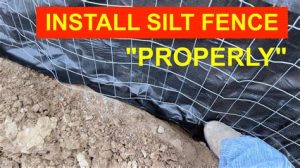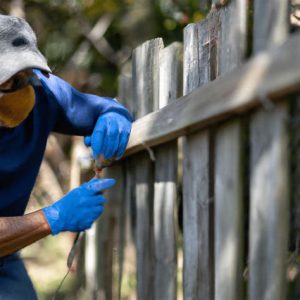Installing a wire fence with T posts can be a straightforward yet rewarding DIY project for homeowners looking to enhance their property’s security or aesthetics. With the right materials and techniques, you can create a sturdy barrier that meets your specific needs. This guide will take you through each step of the process, from selecting the best materials to preparing the ground and positioning your T posts. We’ll cover essential techniques for installing the wire fencing effectively, ensuring durability and functionality. Additionally, we’ll provide maintenance tips to help you keep your fence in pristine condition for years to come. Whether you’re a seasoned DIY enthusiast or a newcomer to home improvement projects, this comprehensive article will equip you with the knowledge you need for a successful installation. Let’s get started on building the perfect wire fence!
How Do You Choose The Right Materials For Your Wire Fence?
Choosing the right materials for your wire fence is crucial to ensure durability, functionality, and aesthetic appeal. Here are some key considerations:
- Determine the Purpose: Understand the main purpose of your fence. Are you enclosing livestock, protecting a garden, or creating a boundary? Different uses may require different materials.
- Select the Type of Wire: There are various types of wire available, such as barbed wire, welded wire, and electric fencing. For livestock, barbed wire might be effective, whereas garden fencing may require a lighter, non-toxic option.
- Gauge of Wire: The gauge or thickness of the wire affects its strength and durability. Generally, lower gauge numbers indicate thicker wire. For instance, a 12-gauge wire is more robust than a 16-gauge wire, making it more suitable for high-traffic areas or larger animals.
- Coating Material: Consider whether the wire is galvanized or coated. Galvanized wire is rust-resistant, while options like vinyl-coated wire offer added protection and aesthetic appeal.
- T Posts Quality: Choose high-quality T posts made of sturdy materials to ensure they withstand weather conditions and the strain of the wire. Look for posts that are rust-resistant and appropriately coated for longevity.
- Fence Height: The height of your fence also matters. If you’re enclosing larger animals, ensure the height is sufficient to prevent escapes or breaches.
- Local Regulations: Check any local regulations or guidelines that dictate specifications for fencing materials. In some regions, certain types of fencing might be favored or even required.
- Budget: Finally, consider your budget but remember that investing in quality materials can lead to lower long-term maintenance costs.
By keeping these factors in mind, you will be well-equipped to make informed decisions about the materials you choose, ensuring that your wire fence meets your specific needs and stands the test of time.
Steps To Prepare The Ground For Installing T Posts
Preparing the ground is a crucial step when installing T posts for your wire fence. Proper preparation ensures that your fence will be sturdy, secure, and long-lasting. Here’s how to go about it:
- Clear the Area: Remove any debris, rocks, or vegetation in the area where you plan to install the T posts. This will provide a clear path for your installation and prevent any obstacles that might hinder the insertion of the posts.
- Measure and Mark: Use stakes and string to outline the exact location of your fence line. Measure your desired distances between posts, usually around 8 to 10 feet apart, depending on the type of fencing you are installing. Ensure the line is straight by checking it with a level.
- Check for Utilities: Before digging, it’s essential to check for underground utilities along your proposed fence line. Contact local utility companies to mark any buried lines to avoid damaging them while installing posts.
- Loosen the Soil: If your ground is hard or compact, consider using a shovel or post driver to loosen up the soil along your marked fence line. This makes it easier to drive the T posts into the ground efficiently.
- Level the Ground: If necessary, level uneven ground to ensure a more stable base for your posts. Filling in low areas with soil or gravel can help create a consistent surface for installation.
By following these steps, you can effectively prepare the ground for installing T posts, ensuring a smoother process when you begin laying your wire fencing.
How To Properly Position And Secure T Posts
Positioning and securing T posts correctly is crucial for the stability and longevity of your wire fence. Follow these steps to ensure that your T posts are installed properly:
By following these steps, you can effectively position and secure your T posts, laying a solid foundation for your wire fence installation.
Techniques For Installing Wire Fencing With T Posts
When it comes to installing wire fencing with T posts, using the right techniques can make a significant difference in both the durability and appearance of your fence. Here are some effective methods to follow:
- How Do You Start with the Right Tools: Ensure you have all necessary tools, including a T post driver, wire cutters, pliers, and gloves. Having the right tools handy will make the installation process smoother.
- How Do You Align the T Posts: Begin by placing the T posts in line with your planned fence layout. Use a string line for guidance to ensure that your posts are straight and evenly spaced, typically 8-10 feet apart.
- How Do You Attach the Wire Fencing: Once the T posts are secured in the ground, start attaching the wire fencing at one end. Use fencing staples or wire to fasten the fencing to the posts. Be sure to pull the wire taut to eliminate sagging.
- How Do You Use Fencing Tensioners: To maintain tension on the wire, use tensioners for added security. Tensioners will keep the wire tight, preventing it from loosening over time.
- How Do You Secure the Bottom: After attaching the upper sections of the wire, ensure that the bottom of the fencing is also secured well. Use ground staples to pin the wire to the soil and prevent animals from burrowing underneath.
- How Do You Check for Alignment: After installing the wire fencing, step back and visually inspect your work. Make any necessary adjustments to ensure that the fencing is straight and properly aligned with the T posts.
Implementing these techniques will not only help in achieving a stable and secure fence but also enhance its overall appearance, making it an attractive addition to your property.
How Do You Maintain Your Installed Wire Fence?
Maintaining your wire fence is crucial to its longevity and effectiveness. Regular inspection and upkeep can help prevent damage and ensure that your fence continues to serve its purpose. Here are some essential steps on how do you maintain your installed wire fence:
By following these maintenance tips, you can ensure that your wire fence remains in good condition for years to come, effectively protecting your property while enhancing its overall appearance.
Frequently Asked Questions
What materials do I need to install a wire fence with T posts?
To install a wire fence with T posts, you will need T posts, wire fencing, fencing insulators, barbed wire or welded wire mesh, a post driver or mallet, wire cutters, and a tape measure.
How deep should I drive the T posts into the ground?
Typically, T posts should be driven at least 2 feet into the ground for stability, but this may vary based on the height of the fence and soil conditions.
Can I install a wire fence by myself, or do I need help?
While it’s possible to install a wire fence by yourself, having a helper can make the process easier, especially when stretching the wire and aligning the posts.
What is the best way to space the T posts?
T posts are usually spaced 8 to 10 feet apart, but the spacing can depend on the type of fencing being used and the specific application.
How do I attach the wire fencing to the T posts?
To attach the wire fencing to the T posts, use fencing insulators or wire ties. Begin at one corner post, and unwind the wire as you go, securing it at regular intervals.
What precautions should I take while installing a wire fence?
Ensure you check for underground utilities before digging, wear appropriate safety gear, and make sure the fence follows property lines and local regulations.
How do I maintain the wire fence after installation?
To maintain the wire fence, regularly check for damage or rust, tighten any loose wires, and clear the area around the fence to prevent plant overgrowth.




